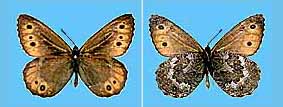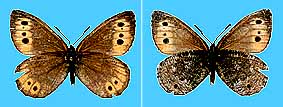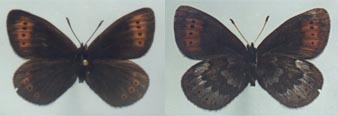
A new subspecies of Parnassius phoebus Fabricius, 1793 from the Northwest of Eastern Siberia (Lepidoptera, Papilionidae)// Atalanta, 1996, 27 (1/2): 189-193.

A new subspecies of Parnassius phoebus Fabricius, 1793 from the Northwest of Eastern Siberia (Lepidoptera, Papilionidae)// Atalanta, 1996, 27 (1/2): 189-193.
Summary: Parnassius
phoebus zamolodtschikovi subspec. nov. is described from the Putorana
plateau, which is situated in the northwestern part of Eastern Siberia.
A detailed diagnosis of the new subspecies is given. It differs from the
nearest polar subspecies P. phoebus uralensis Menetries, 1859, and
P.
phoebus interpositus Herz, 1903, in wing pattern details. Notes on
the ecology of the new subspecies are given. The relationship to the mentioned
polar subspecies of P. phoebus is discussed.
 |
 |
|
|
|
![]()
New subspecies of Erebia anyuica Kurentsov, 1966 and Clossiana erda (Christoph, 1893) from the Vostochnyy Sayan mountains, Russia (Lepidoptera: Nymphalidae)// Phegea, 1996, 24 (4): 157-166.
Summary: Erebia anyuica iltshira ssp. nov. and Clossiana erda kitoica ssp. nov. are described from the Kitoiskye Gol'tsy mountain range (Eastern Saian Mountains). It is the first record of these species in the mountains of southeastern Siberia. Previously both species were known only from the Northeast of Siberia.
Resume: Nouvelles sous-especes
d'Erebia anyuica Kurentsov, 1966 et de Clossiana erda (Christoph,
1893) des Monts Sayan orientaux, Russie (Lepidoptera: Nymphalidae).
Erebia anyuica iltshira ssp. nov. et Clossiana erda
kitoica ssp. nov. sont decrites de la chaine du Kitoiskye Gol'tsy (Monts
Vostochnyy Sayan), jusqu'a present les deux especes n'etaient connues que
du nord-est de la Siberie.
Samenvatting: Nieuwe ondersoorten
van Erebia anyuica Kurentsov, 1966 en Clossiana erda (Christoph,
1893), uit het oostelijke Sayangebergte, Rusland (Lepidoptera: Nymphalidae).
Erebia anyuica iltshira ssp. nov. en Clossiana erda
kitoica ssp. nov. worden beschreven uit de Kitoiskiye Gol'tsy bergketen
(Vostochnyy Sayan gebergte); beide soorten waren tot nu toe slechts bekend
uit Noordoost-Siberie.
 |
 |
|
(to the left - upperside, to the right - underside) |
(to the left - upperside, to the right - underside) |
 |
 |
|
(to the left - upperside, to the right - underside) |
(to the left - upperside, to the right - underside) |
![]()
New and rare species of the Lepidoptera
in the fauna of the Saratov Region. //Problems of the general biology and
applied ecology, Saratov University Publishing, 1997, 145-149 [in Russian].
![]()
Alexei
G. Belik & Roman V. Yakovlev.
Confirmed
occurrence of Oeneis jutta in the Altai mountains (Russia) with
description of a new subspecies (Lepidoptera: Nymphalidae, Satyrinae)
//
Phegea, 1998, 26 (4): 131-139.
Abstract. The presence of Oeneis jutta (Hubner, [1806]) in the Altai mountains is confirmed for the first time since 90 years; a single literature record (Meinhard 1910) was hitherto considered doubtful. Oeneis jutta akoene ssp. n. is described from the Ukok plateau, south-east Altai mountains. It differs well from all known Palaearctic forms of this species. A detailed description and differential diagnosis of the new subspecies is given; its distribution and ecology are discussed.
Resume. Confirmation de
la presence de Oeneis jutta dans le monts Altai (Russie) avec description
d'une nouvelle sous-espece (Lepidoptera: Nymphalidae, Satyrinae)
La presence de Oeneis jutta (Hubner, [1806]) dans les monts Altai
est confirmee pour la premiere foisdepuis90 ans; une seule mention dans
la literature (Meinhard 1910) etait considereee comme douteuse jusqu'a
present. Oeneis jutta akoene ssp. n. est decrite du plateau d'Ukok
, dans le sud-est des monts Altai. Cette sous-espece differe nettement
de toutes les autres formes palearctiques connues de l'espece. Une description
detaillee avec diagnose differentielle est donnee, et la repartition et
l'ecologie de l'espece sont discutees.
Samenvatting. Bevestiging
van het voorkomen van Oeneis jutta in het Altai-gebirge (Rusland),
met beschrijving van een nieuwe ondersoort (Lepidoptera: Nymphalidae, Satyrinae)
De aanwezigheid van Oeneis jutta (Hubner, [1806]) in de Altai wordt
bevestigd. Er waren geen betrouwbarevermeldingen van deze soort uit de
Altai gedurende de laatste 90 jaar; de enige vermelding (Meinhard 1910)
werd steeds als zeer twijfelachtig beschouwd. Van het Ukok plateau, Zuidoost-Altai,
wordt Oeneis jutta akoene ssp. n. beschreven. Deze ondersoort verschilt
van alle bekende Palearktische vormen van de soort. Een gedetailleerde
beschrijving en differentiaaldiagnose worden gegeven, en de verspreiding
en ecologie worden besproken.
 |
 |
|
(to the left - upperside, to the right - underside) |
(to the left - upperside, to the right - underside) |
![]()
On
the correct placement of Erebia epipsodea Buttler, 1868 within the
genus Erebia Dalman, 1816 (Lepidoptera: Satyridae)
//
Journal of Research on the Lepidoptera, 1997 (2000), 36: 16-23.
Abstract. It is demonstraded that the Nearctic species Erebia epipsodea Butler, 1868 is the closest relative to the Palaearctic species Erebia medusa (Denis & Schiffermuller) [1775] and has no affinity with the species of the Alberganus group, in which it was placed previously. This conclusion is suggested by certain details of the male genitalic structure, but is confirmed by the structure of the female genitalia. Therefore E. epipsodea is removed from the Alberganus species group and placed into the Medusa group of species.
![]()
Notes
on the taxonomy and geographical distribution of Erebia dabanensis
Erschoff, 1871 and Erebia fletcheri, Elwes, 1899 with the description
of two new subspecies from the South Transbaikal, Russia (Lepidoptera:
Satyridae)
//
Atalanta, 2001, 32 (1/2): 197-215.
Summary. The taxonomy,
geographical variation, ecology, and distribution of Erebia dabanensis
Erschoff, 1871 and of Erebia fletcheri Elwes, 1899, are discussed.
The lectotype of Erebia dabanensis Erschoff, 1871 is designated.
It is deposited in ZISP. A problem concerning the restriction of the type
locality of Erebia dabanensis Erschoff, 1871 is discussed. The type
locality of Erebia fletcheri Elwes, 1899 is restricted. From the
Sokhondo Mountains (South Transbaikal), two new subspecies are described:
Erebia
dabanensis sokhondoensis subspec. nov. and Erebia fletcheri daurica
subspec. nov.
 |
 |
|
(to the left - upperside, to the right - underside) |
(to the left - upperside, to the right - underside) |
 |
 |
|
(to the left - upperside, to the right - underside) |
(to the left - upperside, to the right - underside) |
![]()
Alexei
G. Belik & Dmitry G. Zamolodchikov.
Notes
on systematics of the Erebia dabanensis species complex, with special
consideration of the dabanensis-youngi and anyuica-occulta
pairs of sibling species (Nymphalidae: Satyrinae)
//
Nota Lepidopterologica, 2002, 25 (1): 61-78.
Summary. There are two
pairs of closely related taxa in the Erebia dabanensis species complex
which deserve special attention. These pairs are: Erebia dabanensis
Erschoff, 1871 - E. youngi Holland, 1900; and E. anyuica
Kurentzov, 1966 - E. occulta Roos & Kimmich, 1983. Relationships
of the taxa within these pairs are analysed. A study of the comparative
morphology of the male genitalia demonstrates that each discussed taxon
is a distinct species. This conclusion is supported by statistically significant
differences in the size proportions of the valvae in the male genitalia,
as well as by results of the cluster analysis. For the first time, two
putatively endemic Nearctic species, i.e. E. youngi and E. occulta,
are discovered in the Palaearctic region, at Northeast Chukotka, thus revealing
trans-Beringian distribution in both cases. All previous records of E.
occulta in the Palaearctic region refer to E. anyuica. The use
of the name E. anyuica Kurentzov, 1966 constitutes a considerable
problem. This is because of the somewhat obscure original description,
while the single type specimen (holotype by monotypy) might be lost. The
name E. anyuica Kurentzov, 1966 should preferably be used for the
endemic Palaearctic species, previously considered as conspecific with
E. occulta, until a thorough re-investigation of the Kurentzov collection
has been performed. Only then the holotype may be rediscovered or a neotype
will be validly designated. The recent designation of a neotype of E.
anyuica (Korb 1999) is considered invalid, as it does not meet the
requirements of the ICZN.
![]()
| Please contact me by e-mail, it is the fastest way. | If email doesn't work, you can write me also by "snail" mail. |

alex_belik-at-san-ru (replace all '-' (dashes) with '.' (dots), then replace .at. with @ to get my actual email address !) |
Alexei G. Belik
P.O. Box 1594 410028, Saratov, 28 RUSSIA |
|---|
![]()
![]()
This page hosted by ![]() Get your own Free Home Page
Get your own Free Home Page
![]()
© 1997-2003 Alexei G. Belik. All rights reserved.